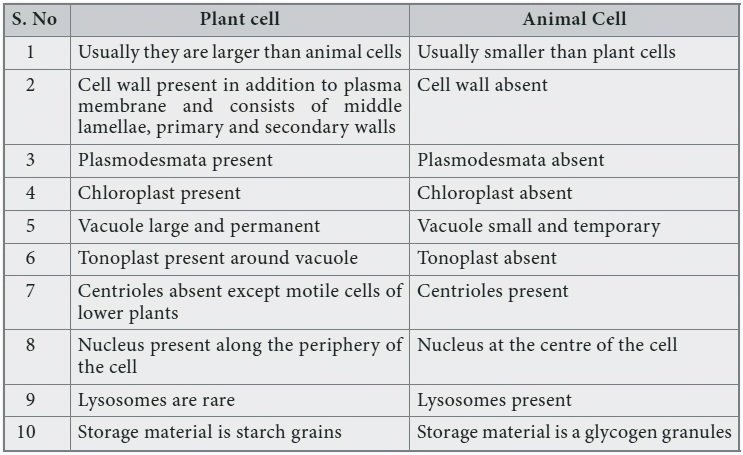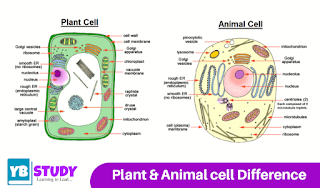Difference Between Animal Cell and Plant Cell
Cells are the foundation of all living things or living things. The human body consists of trillions of cells. They provide structure for the body, take nutrients from food, convert those nutrients into energy, and carry out essential tasks.
Cells also contain hereditary material of the body and can make copies or copies of themselves. Cells have many parts, each of which performs a different function. Some of these parts, called organelles, are specialized structures that perform certain functions inside the cell.

Here below we have given detail Difference Between Animal Cell and Plant Cell. Lets check it.
10 Major Difference Between Animal Cell and Plant Cell
Cell is structural and functional unit of life. There are two types of cells: 1. prokaryotic cell, 2. Eukaryotic cell
Prokaryotic cells: Cells that are not found with nucleic art. And the proteins and nucleic acids found in the nucleus remain in contact with cytoplasm in the absence of DNA and RNA nucleus art. Are called prokaryotic cells. A prokaryotic cell is a cell that does not have a nucleus and does not develop well, but a cell wall in a prokaryotic cell is made up of muron and does not contain histone protein in its chromosome. Examples of prokaryotic cells are Bacteria, Cyanobacteria archaebacteria, Viruses, Bacteriophages, Mycoplasma (PPLO), Blue green algae, Rickettsia cells, etc. The following are the characteristics of prokaryotic organisms:
- Undeveloped and primitive cells are found in these organisms.
- They are small in size.
- The nucleus is not found.
- The nucleus is also not found.
- Only one chromosome is found.
- Cells are also not found surrounded by cell walls.
- Cell division takes place by incomplete division.
- Cyanobacteria such as bacteria and blue-green algae are examples of prokaryotic organisms.
Eukaryotic Cells: Cells that have true nuclei (including nucleus art) and well-developed cells are found. Are called eukaryotic cells. The central substances in these do not remain in direct contact with the cytoplasm but remain in contact with the cytoplasm. Nuclei are found in eukaryotic cells, in which the cell is fully developed, histone proteins are found in the chromosome of eukaryotic cells and are alkaline Examples of eukaryotic cells are all animal cells, protozoa, organisms, plant cells, animals, etc. The following are the characteristics of eukaryotic organisms:
- There are developed and new cells in them.
- They are large.
- The nucleus is found.
- The nucleus is also found.
- More than one chromosome is found.
- Cells are also found surrounded by cell walls.
- Cell division occurs by mitosis and meiosis.
| Animal Cell | Plant cell |
|---|---|
| It does not have a cell wall. | It consists of a cellulose cell wall outside the cell membrane. |
| Are irregular or round in shape. | Are square or rectangular in shape. |
| Centrosomes and centrioles are present. | Centrosomes and centrioles are absent. |
| Plastids are absent | Plastids are present. |
| Vacuoles are usually small and sometimes they are absent. | Vacuoles are few large or single and centrally positioned vacuole. |
| Cilia is present in most animal cells. | Cilia is absent |
| Mitochondria is present and numerous in number. | Mitochondria is present but fewer in number |
| The mode of nutrition is heterotrophic. | The mode of nutrition is primarily autotrophic. |
| Single highly complex and prominent Golgi apparatus is present. | Many simpler units of Golgi apparatus called dictyosomes are present. |
What is the Difference Between Animal Cell and Plant Cell
| Feature | Animal Cell | Plant Cell |
|---|---|---|
| Cell Wall | Absent | Present (composed of cellulose) |
| Chloroplasts | Absent | Present (for photosynthesis) |
| Shape | Generally round or irregular | Generally rectangular or boxy |
| Vacuole | Small or absent | Large central vacuole |
| Centrioles | Present | Absent in most plants |
| Plastids | Absent | Present (chloroplasts, chromoplasts, etc.) |
| Lysosomes | Present | Rare or absent |
| Energy Storage | Glycogen | Starch |
| Plasma Membrane | Present (only cell membrane) | Present (cell membrane inside cell wall) |
| Cytoplasm | Entire cell’s content within the membrane | Entire cell’s content within the membrane |
| Nucleus | Present | Present |
| Golgi Apparatus | Present | Present |
| Endoplasmic Reticulum (ER) | Present (smooth and rough ER) | Present (smooth and rough ER) |
| Ribosomes | Present | Present |
| Mitochondria | Present | Present |
| Cilia | Present in some cells | Usually absent |
| Peroxisomes | Present | Present |
| Cell Division | Mitosis (with centrioles) | Mitosis (without centrioles) |
Write Difference Between Animal Cell and Plant Cell?
Animal Cell
- In Animals cell wall is absent but fount a covering of plasma cell membrane is found outside the plasma cell membrane. Cell wall present in plant cell
- In animal cells, the nucleus is located in the middle of the cell, in plant cells the nucleus is present towards the edge of the cell.
- In animal cell nucleus membrane is present while in plant cells Is absent
- In animal cell Green Leaf is not found while in plant cell Green Leaf is found
- In animal cells chloroplast is absent in plant cells chloroplast Is present
- Animal cells have Vaccuoles which are found in small and large numbers. in plant cells the number of vacuoles is large and their number is small.
- Lysosomes are present in animal cells. In plant cells lysosome Is absent
- Chromosome is present in animal cells. In plant cells The size is small but the chromosome is present but the Size is large
- In animal cells The endoplasmic reticulum is present and its number is more their number is less Photosynthesis does not take place in animal cells. In Plant cells photosynthesis takes place
- In animal cells, the accumulation of carbohydrates is in the form of glycogen. In plant cells Carbohydrates are stored as starch.
Plant Cell
- Primarily animal cells are found to be smaller than plant cells. While the length of plant cells is 10–10 micrometers, on the other hand, the length of animal cells is 10–30 micrometers.
- Animal cells are found in many types such as irregular and round shapes and plant cells are found mainly rectangular or cube-shaped.
- The plant cell which stores energy is in the form of starch and on the other side the animal cell which stores energy is in the form of carbohydrate glycogen.
- In animal cells, only stem cells change their form whereas almost all cells in plant cells can change their form.
- Plant cells enlarge themselves to grow their cells for which they require water while animal cells increase the number of cells to grow their cells.
- A 20-amino protein in an animal cell can produce only 10 proteins whereas a complete 20-amino protein of a plant can synthesize.
- Both cell wall and cell membrane are found in plant cells whereas only cell membrane is found in animal cells.
FAQs on the Difference Between Animal Cells and Plant Cells
1. What is a cell?
Answer: The cell is the basic structural and functional unit of life. It is derived from the Latin word cellula. Which means – a small room. The term cell was first used by Robert Hooke in 1665 AD, with the help of a self-made microscope, he saw a structure similar to a honeycomb in a thin piece of cork. Which he named the cell. Robert Hooke is called the father of cytology.
2. Who gave the cell theory?
Answer: In 1893 AD the botanist M.J. Shlaiden and zoologist Theodore jointly proposed the cell theory.
3. What are the Cellular processes performed by cell :
Answer: Cell performs many functions such as. Autophagy, Adhesion, Generation, Cell organelle, Cell signaling, DNA reconstruction and cell death, Metabolism, Cell division.
4. What are the Functions of the plasma membrane:
Answer: The plasma membrane controls the movement of certain substances into and out of the cell. Therefore, the plasma membrane is also called a selectively permeable membrane.
- Variation: The flow from more dense matter to less dense substance is called diffusion. This flow continues until the density of both substances becomes equal. The rate of diffusion is higher in gaseous substances than in liquids and liquids.
- Osmosis: The flow of water from a part of a high aqueous concentration to a part of a low aqueous concentration using a partially permeable membrane is called osmosis.
- Endocytosis: The ingestion of substances by the cell through the plasma membrane is called endocytosis.
- Exocytosis: In this process, the vesicle membrane collides with the plasma membrane and removes its substances from the surrounding medium. This is called cell vomit.

